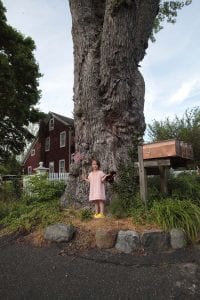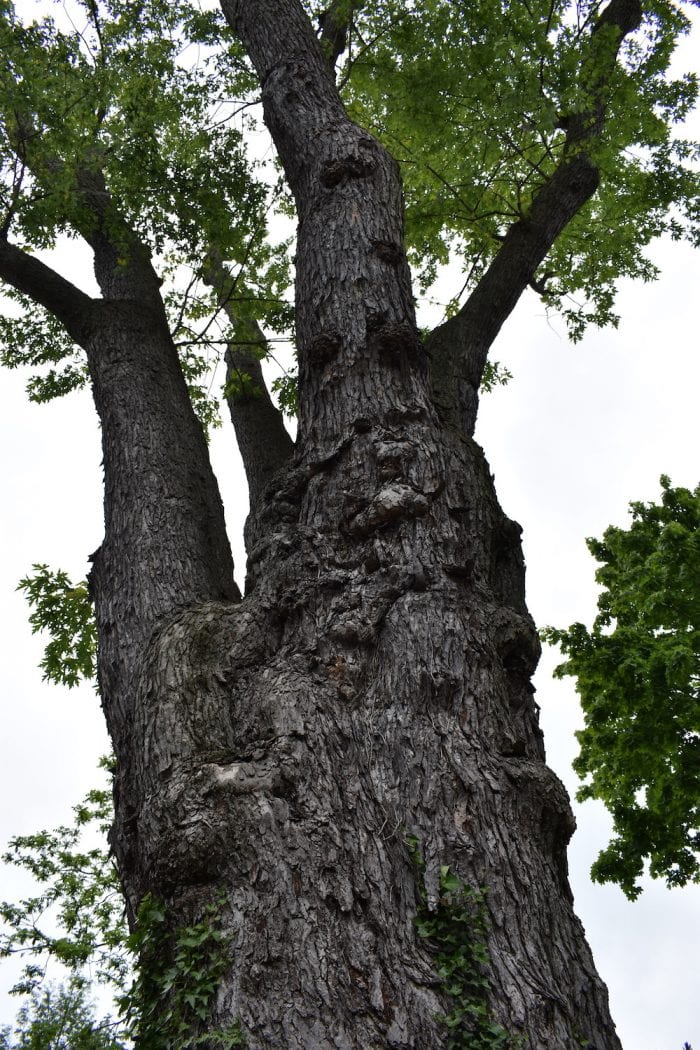Local Historian Says Enormous Tree Likely Has Historical/Community Value
Along a small East Setauket street off Shore Road and near Se-Port Deli, a giant stands dying.
It’s hard to relate just how large it is in words, let alone photos. Nothing does it justice. At approximately 60 feet high and 222 inches in circumference, measured at 4.5 feet off the ground, the enormous silver maple in Setauket is one of the few of its kind that remembers a time potentially up to the Revolutionary period or even further back.

Along Carlton Avenue, in front of Chris Ryon’s house, the best way to gauge the size of it is by comparison. Three-year-old neighbor Dina Amelchenko is dwarfed by it. Ryon, at 5 feet, 7 inches tall, can only reach the crook of the lowest branches with the tips of his fingers.
Ryon, a lifelong area resident and village historian for Port Jefferson and Poquott, has taken care of it for more than two decades. Now its bright bark is flaking off its core, and limbs are starting to tear from the trunk.
“Although the tree has been admired by many, for hundreds of years, it has reached the end of its lifetime,” he said.
Silver maples once lined the streets in the Setauket community, but the tree is not known for its steadfastness over such a long lifespan. Ryon said almost all have fallen or been removed, though none were anywhere near the size of the one in front of his house.
Ryon and his wife Karen purchased the house in 1996 from Fred and Betty Griffith, he said, which meant they also started taking over care of the tree. Prior to their moving in, the Griffiths had installed three cables connecting six of the giant tree branches together. Since then, the Ryons have paid for trimming the maple and removing any of the dead wood, with the help of neighbors Rich and Jeff Usher.
Despite these efforts, the tree still seems to be on its last legs. Some of the tree’s limbs have snapped off and crushed a part of the Ryons’ fence. Others could also come loose and damage neighboring homes or cars.
“We want to document it before it goes, if it does go, since it is unsafe at this point,” Chris Ryon said. “There’s a lot of question marks — we don’t know what the town is going to do with it.”
The race is now on to preserve the great silver maple and find some way to preserve the specimen for future generations.
There are ways to date it, either by bisecting it to count the rings or by coring it using a specially made device, or by carbon dating it. Without state foresters able to take any kinds of measurements, the exact age is still unknown.
John Wernet, the regional state forester of Long Island, said he has had conversations with Ryon but has not been able to go out to see the tree, as the pandemic and state cuts have left him unable to leave his office. Though he said the tree is not the biggest tree of its type in New York state, based solely on its circumference, it could easily be one of the largest on Long Island, if nothing else.
The state keeps a registry of all large trees, but the list does not offer any kind of protections.
“It’s more for bragging rights,” he said, adding that there is little he can do on the state side in tree preservation efforts, though he hopes the silver maple can somehow be protected.
Setauket groups are especially keen on preserving local history. with entities like the Three Village Historical Society and its annual Culper Spy Day event. Ryon said the tree could be used by local historical societies, where even a bisection of the tree could show what years showed more or less rain, and even relate which years local or national historical events took place.
The question lingers on what can be done to or for the tree. Three Village Civic Association 1st Vice President George Hoffman said the organization was just recently contacted about it, but said that they want to work with both residents and the town to help preserve the giant maple in some way, shape or form.
“I know highways [department] have responsibility, but that should be the last resort to take down a tree,” Hoffman said. “We’re here to support the community, but it’s still really early.”
Those in the community who were there in the 1970s are still burned by the loss of another tree, known as the Lubber Street Oak at the corner of Lubber and Black Duck Drive in Stony Brook. According to a bronze plaque residents set up at the site, the tree stood at 84 feet tall with a circumference of 280 inches. It was believed to be over 300 years old when it was taken down by the Town of Brookhaven Highway Department in 1979.
Bill Schaub, the Ryons’ neighbor and member and past president of the civic, said they would like the tree preserved in some way, especially considering residents’ past consternation with local government unilaterally removing those trees without first speaking to residents.
“If it has to be cut down because of disease then that’s understandable, there has to be a balance between beauty and safety,” he said. “But I think we can achieve that.”
A Highway Department spokesperson said the tree was only recently brought to the department’s attention, and no final decision has been made.







